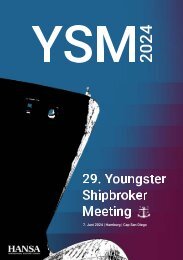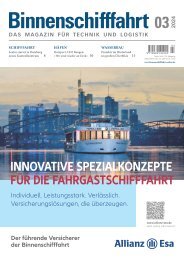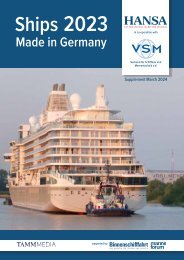HANSA 06-2019
Reparatur & Umbau | Start-Ups | COMPIT Review | CIMAC 2019 | Terminaltechnik | Batterien & Hybrid | Offshore-Flotte | U.A.E. | Cruise Ship Interiors | Zeaborn & Offen
Reparatur & Umbau | Start-Ups | COMPIT Review | CIMAC 2019 | Terminaltechnik | Batterien & Hybrid | Offshore-Flotte | U.A.E. | Cruise Ship Interiors | Zeaborn & Offen
Erfolgreiche ePaper selbst erstellen
Machen Sie aus Ihren PDF Publikationen ein blätterbares Flipbook mit unserer einzigartigen Google optimierten e-Paper Software.
Schiffstechnik | Ship Technology<br />
LNG being sulphur free is also helping<br />
the fight against GHG. Dual-fuel engines<br />
burning methane (the main constituent<br />
of LNG) produce less CO2 per kWh than<br />
engines burning liquid fuels. This is because<br />
methane (CH4) has the lowest ratio<br />
of carbon to hydrogen of hydrocarbon<br />
fuels. The methane slip is of course<br />
something we need to consider, and we<br />
are supporting researching activities here<br />
accordingly.<br />
Finally, engine component and engine<br />
consumable manufacturers are constantly<br />
working to reduce friction as a means<br />
of raising engine efficiency. Remote monitoring,<br />
control, and diagnostics are also<br />
starting to benefit fuel consumption and<br />
helping the shipping industry become<br />
more efficient as a whole.<br />
Do conventional diesel engines still play<br />
a role on the market or is dual fuel already<br />
the new standard solution?<br />
Tonon: I do not see a full renunciation of<br />
diesel engines. Applications for dual-fuel<br />
engines are certainly growing, especially<br />
in short-sea applications like container<br />
feeders, ferries and offshore vessels. The<br />
likely scenario for ocean-going vessels<br />
in the foreseeable future will be dual-fuel<br />
engines in NO x and sulphur Emission<br />
Control Areas (ECA), while reverting to<br />
diesel engines on the high seas.<br />
A new-built vessel without batteries on<br />
board for peak shaving or emission free<br />
port operation – will this be even possible<br />
in a few years from now?<br />
Tonon: Certainly, we are going to see<br />
many ships with electric and hybrid<br />
propulsion systems featuring batteries<br />
and fuel cells. There are already many<br />
pilot projects and commercial diesel-electric<br />
and hybrid applications for<br />
vessels with more than one operating<br />
mode. This includes ferries that dock<br />
and manoeuvre frequently and tugs that<br />
can operate on batteries when moving<br />
between tows. There are also offshore<br />
vessels that can switch to electric power<br />
when cruising to and from oilrigs<br />
and production platforms but use their<br />
combustion engines, continuously or<br />
intermittently, when handling anchors<br />
or fully loaded.<br />
At the other extreme, based on the<br />
current state-of-the-art, there is a limited<br />
scope for battery or fuel cell power<br />
on ocean-going ships. Neither power<br />
sources can achieve the power density or<br />
power-to weight and power-to-space ratios<br />
typical of combustion engine propulsion.<br />
Fitting these large ships with batteries<br />
or fuel cells only for use in ECAs or<br />
harbours would rob them of a great deal<br />
of payload.<br />
How do you estimate the market potential<br />
for bio fuels – a big opportunity for<br />
conventional engine technology?<br />
Tonon: Low emission sustainable fuels<br />
will be the key to the internal combustion<br />
engine maintaining its position as<br />
the shipping industry’s prime mover of<br />
choice. However, a limiting factor with<br />
<strong>HANSA</strong> International Maritime Journal <strong>06</strong> | <strong>2019</strong><br />
53


















